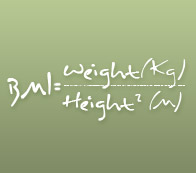 BMI (Body Mass Index) is a popular measurement used to determine if a person is below, within, or above a healthy weight range. BMI does not measure fat mass but measures appropriateness of a person’s weight in relation to their height. To calculate your BMI you need to divide your weight (in kilograms) by your height squared (in meters), just use the formula on the picture. The resulting is the number of kilograms per square meters of body surface and is compared to reference ranges to indicate your weight status.
BMI (Body Mass Index) is a popular measurement used to determine if a person is below, within, or above a healthy weight range. BMI does not measure fat mass but measures appropriateness of a person’s weight in relation to their height. To calculate your BMI you need to divide your weight (in kilograms) by your height squared (in meters), just use the formula on the picture. The resulting is the number of kilograms per square meters of body surface and is compared to reference ranges to indicate your weight status.
Here’s what figures you get mean.
- An underweight status is indicated by a BMI of 18.5 or less.
- The normal, or ‘healthy’ weight range is 18.5-25.
- Overweight status is from 25-30.
- Obesity is classified as any BMI over 30.
These reference ranges may differ for certain racial groups, and the healthy weight range starts at 20 for those aged over 65 because of the health risks associate with malnutrition in the elderly population.
A ‘normal’ BMI is associated with a reduced risk of developing lifestyle diseases such as heart disease, cancer, and diabetes.
While body mass index is mostly an easy and effective way to screen for underweight or overweight and obese individuals, it is not a perfect measure. BMI does not take into account frame size or muscle mass. People with wider skeletal frames or high muscle mass may fall within an ‘overweight’ or ‘obese’ reference range when they in fact have very low body fat, and therefore still have a low risk of lifestyle diseases.
People with a broad figure or high muscle mass may benefit from asking their GP, dietitian or personal trainer to take skin fold measurements. This gives a better indication of body fat, and may help you to monitor fat loss which may not be evident in the form of weight loss due to an increase in muscle mass.
BMI is not the be all and end all of healthy weight measurements, and your energy levels, exercise tolerance, fat distribution around your body, blood pressure and general health should also be taken into consideration. Aiming for a weight goal within the healthy weight range can however be a great target to work towards, particularly if you do not have a wide skeletal frame or high muscle mass. Aiming for a healthy body mass index weight can help you form a realistic goal as well as reducing health risks associated with an unhealthy weight.
About the Author
Australian Lifestyle & Fitness is an online weight loss company that provides its members with interactive Weight Loss programs. The program is based on a unique diet profile and your weight loss goals and food choices. Australian Lifestyle & Fitness believe that you can lose weight without losing your lifestyle. The program has been a smash hit in Australia, New Zealand and is now expanding into the US & UK. Visit weight loss for more information.










